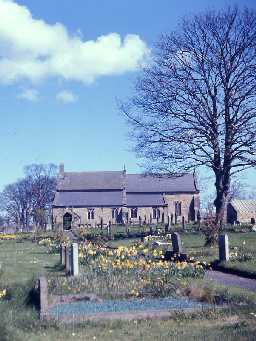Church of the Holy Trinity (Widdrington Village)
Parish church had late 12th century nave remodelled and extended in mid-14th century. (1)
North aisle demolished in medieval period and rebuilt in 19th century with organ chamber. (2)
The church preserves many medieval features. Certain problems posed: the size of the Norman church - the two-bay nave is very short. The west end may have been shortened. Also a problem with the date of the later medieval remodelling, stylistically 13th and 14th century characteristics. (3)
Church contains a war memorials as:
* a plaque inscribed "IN BRIGHT AND LOVING MEMORY OF/ HUGH CLARKSON ANNETT, LIEUT./ 6TH DURHAM LIGHT INFANTRY/ WHO FELL IN ACTION IN FRANCE ON/ SEPTEMBER 16TH 1916, AGED 30 YEARS."
* as a brass memorial plaque inscribed "IN MEMORY OF THE FALLEN/ OF THIS PARISH/ 1939-1945". (4)(5)
Most of the church dates to around 1340, based on documentary evidence, but its origins remain a mystery. It is not known if it was a pre- or post-Conquest foundation but has the potential to preserve archaeological material in below-floor deposits despite the introduction of an underfloor heating system in the 19th century and subsequent remodelling in the 20th century. A considerable number of burials are to be expected under the floor and the Widdrington vault lies under the sanctuary. The vault was noted in 1826 and appears to have lain undisturbed since the church restoration in 1874. (6)
North aisle demolished in medieval period and rebuilt in 19th century with organ chamber. (2)
The church preserves many medieval features. Certain problems posed: the size of the Norman church - the two-bay nave is very short. The west end may have been shortened. Also a problem with the date of the later medieval remodelling, stylistically 13th and 14th century characteristics. (3)
Church contains a war memorials as:
* a plaque inscribed "IN BRIGHT AND LOVING MEMORY OF/ HUGH CLARKSON ANNETT, LIEUT./ 6TH DURHAM LIGHT INFANTRY/ WHO FELL IN ACTION IN FRANCE ON/ SEPTEMBER 16TH 1916, AGED 30 YEARS."
* as a brass memorial plaque inscribed "IN MEMORY OF THE FALLEN/ OF THIS PARISH/ 1939-1945". (4)(5)
Most of the church dates to around 1340, based on documentary evidence, but its origins remain a mystery. It is not known if it was a pre- or post-Conquest foundation but has the potential to preserve archaeological material in below-floor deposits despite the introduction of an underfloor heating system in the 19th century and subsequent remodelling in the 20th century. A considerable number of burials are to be expected under the floor and the Widdrington vault lies under the sanctuary. The vault was noted in 1826 and appears to have lain undisturbed since the church restoration in 1874. (6)
N11885
DESK BASED ASSESSMENT, The Church of the Holy Trinity, Widdrington 2020; Peter Ryder
Disclaimer -
Please note that this information has been compiled from a number of different sources. Durham County Council and Northumberland County Council can accept no responsibility for any inaccuracy contained therein. If you wish to use/copy any of the images, please ensure that you read the Copyright information provided.
